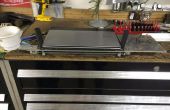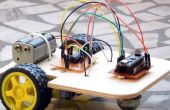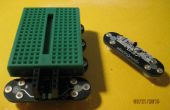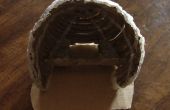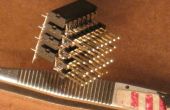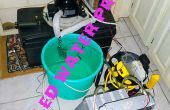Paso 4: Preparar el código de Arduino
Incluyen la biblioteca de abajo. El servo es la librería de servos por defecto que viene con el software sketch de Arduino.
Definir las Variables constantes
Usted tendrá que establecer estos valores dependiendo del protocolo y códigos control remotos que está utilizando. Estas son de mi hobby remoto. Ver la biblioteca de IRLib adjuntada para referencias en el protocolo de IRLib.
#define MY_PROTOCOL NEC#define RIGHT_ARROW 0xFF02FD // PLAY main loop (power)#define LEFT_ARROW 0xFF22DD // SERVO POSITION 2#define POWER 0xFFA25D // SERVO POSITION 2 POWER#define PLAY 0xFFC23D // PLAY AUTO LOOP#define RETURN 0xFFB04F // LEAVE AUTOMATIC LOOP#define MUTE 0xFFE21D // OFF const int SFX_4 = 4; const int SFX_2 = 5;const int SFX_RST = 6;const int SFX_vol = 7;const int sensor1_pwr = A4;const int sensor2_pwr = A5;const int sensor1 = A0;const int sensor2 = A1;const int LEDON = 10;
Definir cambio de Variables
int _SFX_4 = HIGH; int _SFX_2 = HIGH;int _SFX_RST = HIGH;int _SFX_vol = HIGH;int pos1;int pos2;int Read1NEW = 400;int Read1OLD = 400;int Read2NEW = 400;int Read2OLD = 400;int state = 0int n = 0;int m = 0;int w = 0;int prevMillis = 0;long previousMillis = 0;
Definir servos:
Servo servo1; // Define servoServo servo2; // Define servo
Utilice este segmento de código para el receptor de infrarrojos:
IRrecv My_Receiver(11); //Receive on pin 11IRdecode My_Decoder;
Configuración:
void setup(){ // begin setupSerial.begin(9600); // Begin serial communicationMy_Receiver.No_Output(); // Turn off any unused IR LED output circuitMy_Receiver.enableIRIn(); // Starts the receiver for IR remote Definir modos de Pin
pinMode(SFX_2,OUTPUT);digitalWrite(SFX_2,_SFX_2);pinMode(SFX_4,OUTPUT);digitalWrite(SFX_4,_SFX_4);pinMode(SFX_vol,OUTPUT);digitalWrite(SFX_vol,_SFX_vol);pinMode(SFX_RST,OUTPUT);digitalWrite(SFX_RST,_SFX_RST);pinMode(sensor1_pwr,OUTPUT);digitalWrite(sensor1_pwr,HIGH);pinMode(sensor1_pwr,OUTPUT);digitalWrite(sensor1_pwr,HIGH);pinMode(sensor2_pwr,OUTPUT);digitalWrite(sensor2_pwr,HIGH); pinMode(LEDON,OUTPUT);digitalWrite(LEDON,LOW);
Conecte los Servos:
servo1.attach(8);servo2.attach(9);
} // end setup
Bucle principal:
Este segmento de código es comentado por lo que no voy a repetir el propósito de los códigos.
void loop(){ // begin main loop bailout1:{ servo1.detach(); // Detach Servo, prevents servo noise servo2.detach(); // Detach Servo, prevents servo noise int V1 = 0; // Variable for while loop below while (V1 == 0){ if (My_Receiver.GetResults(&My_Decoder)) { My_Decoder.decode(); if(My_Decoder.decode_type==MY_PROTOCOL) { switch(My_Decoder.value) { case MUTE:{ digitalWrite(LEDON,LOW); Serial.println("POWER OFF"); servo1.attach(8); // Attaches servo 1 servo2.attach(9); // Attaches servo 2 servo1.write(95); // low position is 95 deg servo2.write(100); // low position is 100 deg delay(500); goto bailout1; } case POWER:{ Serial.println("POWER ON"); digitalWrite(LEDON,HIGH); int V2 = 0; while (V2 == 0) { // Detach all servos so that vibrations sensors do not pick up any // servo vibration or whine. //---------------------------------------------------------------------- servo1.detach(); servo2.detach(); // Nested Loop Wich Sets Initial Conditions for SFX board // In this case, it is used for adjusting volume. // Go to https://learn.adafruit.com/adafruit-audio-fx-soun... // for a detailed tutorial on how the Adafruit FX board works. // The segment of code below is essentially turning the volume // down by a crude method. //---------------------------------------------------------------------- while(n < 1){ n++; Serial.print("Resetting FX Sound Board..."); digitalWrite(SFX_RST,LOW); delay(40); digitalWrite(SFX_RST,HIGH); Serial.println("Complete"); } while(m < 26){ m++; digitalWrite(SFX_vol,LOW); delay(40); digitalWrite(SFX_vol,HIGH); delay(40); if(m == 26){ Serial.println("Complete"); } if(m == 1){ Serial.print("Checking Volume Level..."); }} //---------------------------------------------------------------------- bailout2:{ // Used to escape from nested loops below //---------------------------------------------------------------------- // Remote Control Interface //---------------------------------------------------------------------- // For info on how to use the IR remote control with the Arduino // visit https://github.com/cyborg5/IRLib // There are manuals and examples. //---------------------------------------------------------------------- if (My_Receiver.GetResults(&My_Decoder)) { My_Decoder.decode(); if(My_Decoder.decode_type==MY_PROTOCOL) { switch(My_Decoder.value) { //---------------------------------------------------------------------- // The next two case statements are used to alternate servo positions // with the push of the button (right or left arrow on IR remote) //---------------------------------------------------------------------- case MUTE:{ digitalWrite(LEDON,LOW); Serial.println("POWER OFF"); servo1.attach(8); // Attaches servo 1 servo2.attach(9); // Attaches servo 2 servo1.write(95); // low position is 95 deg servo2.write(100); // low position is 100 deg delay(500); goto bailout1; // exit ON loop } case LEFT_ARROW:{ servo1.attach(8); // Attaches servo 1 servo2.attach(9); // Attaches servo 2Serial.println("MANUAL PLAY 1"); digitalWrite(SFX_4,LOW); // enables sound delay(400); // delay for sound digitalWrite(SFX_4,HIGH); // enables sound servo1.write(95); // High position is 125 deg servo2.write(75); // low position is 100 deg delay(2000); // delay for timing state = 1; // state for determining which sensor was last break; // exit loop } case RIGHT_ARROW: { servo1.attach(8); // Attaches servo 1 servo2.attach(9); // Attaches servo 2 Serial.println("MANUAL PLAY 2"); digitalWrite(SFX_4,LOW); // enables sound delay(400); // delay for sound digitalWrite(SFX_4,HIGH); // enables sound servo1.write(125); // low position is 95 deg servo2.write(100); // high position is 75 deg delay(2000); // delay for timing state = 0; // state for determining which sensor was last break; // exit loop } //********************************************************************** // This segment enables the automated play mode //********************************************************************** case PLAY: { Serial.println("Entering Automated Play Mode"); int q = 0; while(q==0) { //---------------------------------------------------------------------- // This segment of code is used to break out of the automated play mode //---------------------------------------------------------------------- if (My_Receiver.GetResults(&My_Decoder)) { My_Decoder.decode(); if(My_Decoder.decode_type==MY_PROTOCOL) { switch(My_Decoder.value) { case RETURN: { Serial.println("Leaving Automated Play Mode"); delay(10); servo1.attach(8); // Attaches servo 1 servo2.attach(9); // Attaches servo 2 servo1.write(95); // low position is 95 deg servo2.write(100); // low position is 100 deg delay(500); w=0; goto bailout2; // exits play loop }}} My_Receiver.resume(); } //---------------------------------------------------------------------- // Initially positions servo at beginning of automated play mode //---------------------------------------------------------------------- while(w < 1) { w++; // variable for loop servo1.attach(8); // Attaches servo 1 servo2.attach(9); // Attaches servo 2 delay(1); // delay for stability servo1.write(95); // positions servo High is 120 deg servo2.write(75); // positions servo low is 100 deg delay(20); // delay for timing servo1.detach(); // Detach Servo, prevents servo noise servo2.detach(); // Detach Servo, prevents servo noise //---------------------------------------------------------------------- //This segment Plays song to indicate you have entered automatic play mode //---------------------------------------------------------------------- digitalWrite(SFX_2,LOW); delay(400); digitalWrite(SFX_2,HIGH); } //---------------------------------------------------------------------- // Stores readings for sensor 1 & 2 in a variable //---------------------------------------------------------------------- Read1NEW = analogRead(sensor1); // stores sensor value delay(1); // delay for stability Read2NEW = analogRead(sensor2); // stores sensor value delay(1); // delay for stability //---------------------------------------------------------------------- // Changes servo positions when a sensor is disturbed //---------------------------------------------------------------------- //---------------------------------------------------------------------- // SERVO / SENSOR 1 CONDITIONAL STATEMENT //---------------------------------------------------------------------- if((Read1NEW > 750) && (state == 0)) { Serial.println("Disturbance Detected in Sensor 1"); //---------------------------------------------------------------------- // This segment Plays sound indicating ball has been disturbed //---------------------------------------------------------------------- digitalWrite(SFX_4,LOW); delay(360); digitalWrite(SFX_4,HIGH); //---------------------------------------------------------------------- Read1NEW = 0; // stores sensor reading for sensor 1 Read2NEW = 0; // stores sensor reading for sensor 2 digitalWrite(sensor1_pwr,LOW); // temp disables sensor digitalWrite(sensor2_pwr,LOW); // temp disables sensor servo1.attach(8); // Attaches servo 1 servo2.attach(9); // Attaches servo 2 delay(1500); servo1.write(95); // Up position is 125 servo2.write(75); // Down position is 100 servo1.detach(); // Detach Servo, prevents servo noise servo2.detach(); // Detach Servo, prevents servo noise delay(1000); // delay for timing state = 1; // state for determining which sensor was last } //---------------------------------------------------------------------- // SERVO / SENSOR 2 CONDITIONAL STATEMENT //---------------------------------------------------------------------- if((Read2NEW > 750) && (state == 1)) { Serial.println("Disturbance Detected in Sensor 2"); //---------------------------------------------------------------------- // This segment Plays sound indicating ball has been disturbed //---------------------------------------------------------------------- digitalWrite(SFX_4,LOW); delay(360); digitalWrite(SFX_4,HIGH); //---------------------------------------------------------------------- Read1NEW = 0; // stores sensor reading for sensor 1 Read2NEW = 0; // stores sensor reading for sensor 2 digitalWrite(sensor1_pwr,LOW); // temp disables sensor digitalWrite(sensor2_pwr,LOW); // temp disables sensor servo1.attach(8); // Attaches servo 1 servo2.attach(9); // Attaches servo 2 delay(1500); // delay for timing servo1.write(125); // low is 95 servo2.write(100); // high is 75 servo1.detach(); // Detach Servo, prevents servo noise servo2.detach(); // Detach Servo, prevents servo noise delay(1000); // delay for timing state = 0; // state for determining which sensor was last } else { digitalWrite(SFX_4,HIGH); // Keeps sound effect pin high (OFF) if ((analogRead(sensor2) < 350) && (analogRead(sensor1) < 350)) { digitalWrite(sensor1_pwr,HIGH); // enables sensor digitalWrite(sensor2_pwr,HIGH); // enables sensor }}}}}} My_Receiver.resume(); }}}}}} My_Receiver.resume(); }}}} //********************************************************************** //**********************************************************************
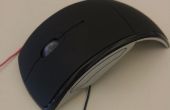
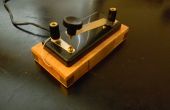
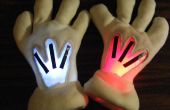

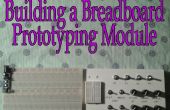
![[Prototipo] La mesa [Prototipo] La mesa](https://foto.askix.com/thumb/170x110/b/d5/bd572895e3c0314a13eb72a72a320008.jpg)
